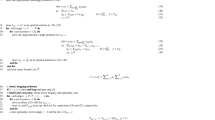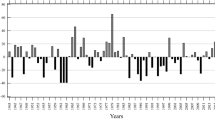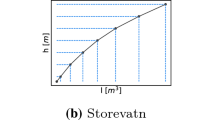Abstract
We consider a multistage stochastic linear program in which we aim to assess the quality of an operational policy computed by means of a stochastic dual dynamic programming algorithm. We perform policy assessment by considering two strategies to compute a confidence interval on the optimality gap: (i) using multiple scenario trees and (ii) using a single scenario tree. The first approach has already been considered in several applications, while the second approach has been discussed previously only in a two-stage framework. The second approach is useful in practical applications in order to more quickly assess the quality of a policy. We present these ideas in the context of a multistage stochastic program for Brazilian long-term hydrothermal scheduling, and use numerical instances to compare the confidence intervals on the optimality gap computed via both strategies. We further consider the relative merits of using naive Monte Carlo sampling, randomized quasi Monte Carlo sampling, and Latin hypercube sampling within our framework for assessing the quality of a policy.






Similar content being viewed by others
Notes
Results were obtained using a 10-processor machine with 32 GB of RAM, a high-performance 300 GB SAS 15,000 rpm disk, and Windows Server 2008 R2 Standard Edition, where each processor has two 1333 MHz Intel Xeon X5690 cores. To solve the linear programming subproblems at each stage, we use Gurobi 4.61.
References
Banks, J., Carson II, J. S., Nelson, B. L., & Nicol, D. M. (2010). Discrete-event system simulation (5th ed.). Upper Saddle River: Prentice Hall.
Bayraksan, G., & Morton, D. P. (2006). Assessing solution quality in stochastic programs. Mathematical Programming, 108, 495–514.
Bayraksan, G., & Morton, D. P. (2011). A sequential sampling procedure for stochastic programming. Operations Research, 59, 898–913.
Charbeneau, R. J. (1978). Comparison of the two- and three-parameter log normal distributions used in streamflow synthesis. Water Resources Research, 14, 149–150.
Chen, Z. L., & Powell, W. B. (1999). Convergent cutting-plane and partial-sampling algorithm for multistage stochastic linear programs with recourse. Journal of Optimization Theory and Applications, 102(3), 497–524.
Chiralaksanakul, A., & Morton, D. P. (2004). Assessing policy quality in multi-stage stochastic programming. The Stochastic Programming E-Print Series. www.speps.info.
de Matos, V. L., & Finardi, E. (2012). A computational study of a stochastic optimization model for long term hydrothermal scheduling. International Journal of Electrical Power and Energy Systems, 43, 1443–1452.
de Matos, V. L., Philpott, A. B., & Finardi, E. (2015). Improving the performance of stochastic dual dynamic programming. Journal of Computational and Applied Mathematics, 290, 196–208.
de Queiroz, A. R., & Morton, D. P. (2013). Sharing cuts under aggregated forecasts when decomposing multi-stage stochastic programs. Operations Research Letters, 41, 311–316.
Donohue, C. J. (1996). Stochastic network programming and the dynamic vehicle allocation problem. Ph.D. thesis, The University of Michigan, Ann Arbor.
Donohue, C. J., & Birge, J. R. (2006). The abridged nested decomposition method for multistage stochastic linear programs with relatively complete recourse. Algorithmic Operations Research, 1, 20–30.
Fox, B. L. (1999). Strategies for Quasi-Monte Carlo. Berlin: Kluwer Academic Publishers.
Girardeau, P., Leclere, V., & Philpott, A. B. (2014). On the convergence of decomposition methods for multistage stochastic convex programs. Mathematics of Operations Research, 40, 130–145.
Guigues, V. (2014). SDDP for some interstage dependent risk averse problems and application to hydro-thermal planning. Computational Optimization and Applications, 57, 167–203.
Higle, J. L., & Sen, S. (1991). Statistical verification of optimality conditions for stochastic programs with recourse. Annals of Operations Research, 30, 215–240.
Homem-de Mello, T., de Matos, V. L., & Finardi, E. C. (2011). Sampling strategies and stopping criteria for stochastic dual dynamic programming: a case study in long-term hydrothermal scheduling. Energy Systems, 2, 1–31.
Høyland, K., & Wallace, S. W. (2001). Generating scenario trees for multi-stage decision problems. Management Science, 47, 295–307.
Infanger, G., & Morton, D. P. (1996). Cut sharing for multistage stochastic linear programs with interstage dependency. Mathematical Programming, 75, 241–256.
Kaut, M., & Wallace, S. W. (2007). Evaluation of scenario-generation methods for stochastic programming. Pacific Journal of Optimization, 3, 257–271.
Kozmík, V., & Morton, D. P. (2015). Risk-averse stochastic dual dynamic programming. Mathematical Programming, 152, 275–300.
Maceira, M. E. P., Mercio, C. B., Gorenstin, B. G., Cunha, S. F. H., Suanno, C., Sacramento, M. C., & Kligerman, A. S. (1998). Energy evaluation of the north/northeastern and south/southeastern interconnection with NEWAVE model. In VI Symposium of specialists in electric operational and expansion planning—SEPOPE.
Maceira, M. E. P., Terry, L. A., Costa, F. S., Damazio, J. M., & Melo, A. C. G. (2002). Chain of optimization models for setting the energy dispatch and spot price in the Brazilian system. In 14th Power systems computation conference.
Mak, W. K., Morton, D. P., & Wood, R. K. (1999). Monte Carlo bounding techniques for determining solution quality in stochastic programs. Operations Research Letters, 24, 47–56.
McKay, M. D., Beckman, R. J., & Conover, W. J. (1979). Comparison of three methods for selecting values of input variables in the analysis of output from a computer code. Technometrics, 21, 239–245.
Morton, D. P. (1996). An enhanced decomposition algorithm for multistage stochastic hydroelectric scheduling. Annals of Operations Research, 64, 211–235.
Morton, D. P. (1998). Stopping rules for a class of sampling-based stochastic programming algorithms. Operations Research, 46, 710–718.
Niederreiter, H. (1992). Random number generation and quasi-monte carlo methods. In CBMS-NSF regional conference series in applied mathematics. Philadelphia: SIAM.
Pereira, M. V. F., & Pinto, L. M. V. G. (1991). Multi-stage stochastic optimization applied to energy planning. Mathematical Programming, 52, 359–375.
Philpott, A. B., & Guan, Z. (2008). On the convergence of stochastic dual dynamic programming and related methods. Operations Research Letters, 36, 450–455.
Philpott, A. B., & de Matos, V. L. (2012). Dynamic sampling algorithms for multi-stage stochastic programs with risk aversion. European Journal of Operational Research, 218, 470–483.
Rebennack, S., Flach, B., Pereira, M. V. F., & Pardalos, P. M. (2012). Stochastic hydro-thermal scheduling under \(\text{ CO }_{2}\) emissions constraints. IEEE Transactions on Power Systems, 27, 58–68.
Shapiro, A. (2011). Analysis of stochastic dual dynamic programming method. European Journal of Operational Research, 209, 63–72.
Shapiro, A., & Homem-de-Mello, T. (1998). A simulation-based approach to two-stage stochastic programming with recourse. Mathematical Programming, 81, 301–325.
Shapiro, A., Tekaya, W., da Costa, J. P., & Soares, M. P. (2012). Report for technical cooperation between Georgia Institute of Technology and ONS—Operador Nacional do Sistema Elétrico—phase 1. http://www2.isye.gatech.edu/people/faculty/Alex_Shapiro/ONS-1.pdf. Accessed 24 Jan 2016.
Tanrisever, F., Morrice, D., & Morton, D. P. (2012). Managing capacity flexibility in make-to-order production environments. European Journal of Operational Research, 216, 334–345.
Acknowledgments
The authors thank two anonymous referees whose comments and suggestions improved this paper.
Author information
Authors and Affiliations
Corresponding author
Rights and permissions
About this article
Cite this article
de Matos, V.L., Morton, D.P. & Finardi, E.C. Assessing policy quality in a multistage stochastic program for long-term hydrothermal scheduling. Ann Oper Res 253, 713–731 (2017). https://doi.org/10.1007/s10479-016-2107-6
Published:
Issue Date:
DOI: https://doi.org/10.1007/s10479-016-2107-6




